Travel and Tourism Business Toolkit: Sales, HR, Ethics, and Budgets
VerifiedAdded on 2023/01/05
|17
|5226
|55
Report
AI Summary
This report analyzes the Travel and Tourism Business Toolkit, focusing on Jet 2.com as a case study. It explores key principles of revenue management, including yield management and its role in sales control, cost reduction, branding, and attracting guests. The report delves into the HR lifecycle, particularly the attraction, induction, career planning, retention, and separation stages, using the example of a tour guide. Furthermore, it examines performance management plans. Finally, it addresses legislation and ethical considerations within the travel and tourism sector, including the potential impact of these factors on business operations, and includes a section on managing budgets and financial records. The report provides a comprehensive overview of these interconnected elements for successful business operations within the travel and tourism industry.
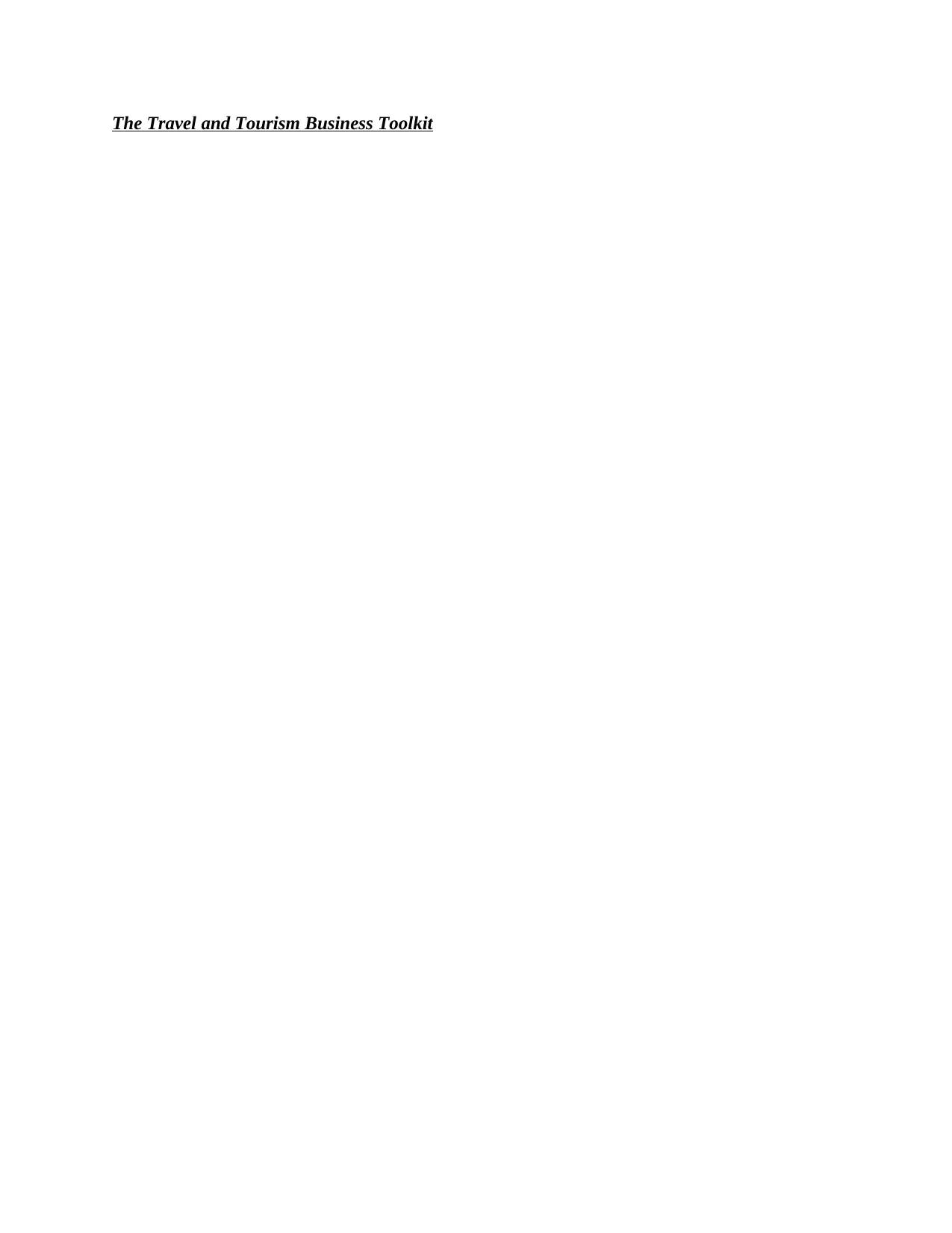
The Travel and Tourism Business Toolkit
Paraphrase This Document
Need a fresh take? Get an instant paraphrase of this document with our AI Paraphraser
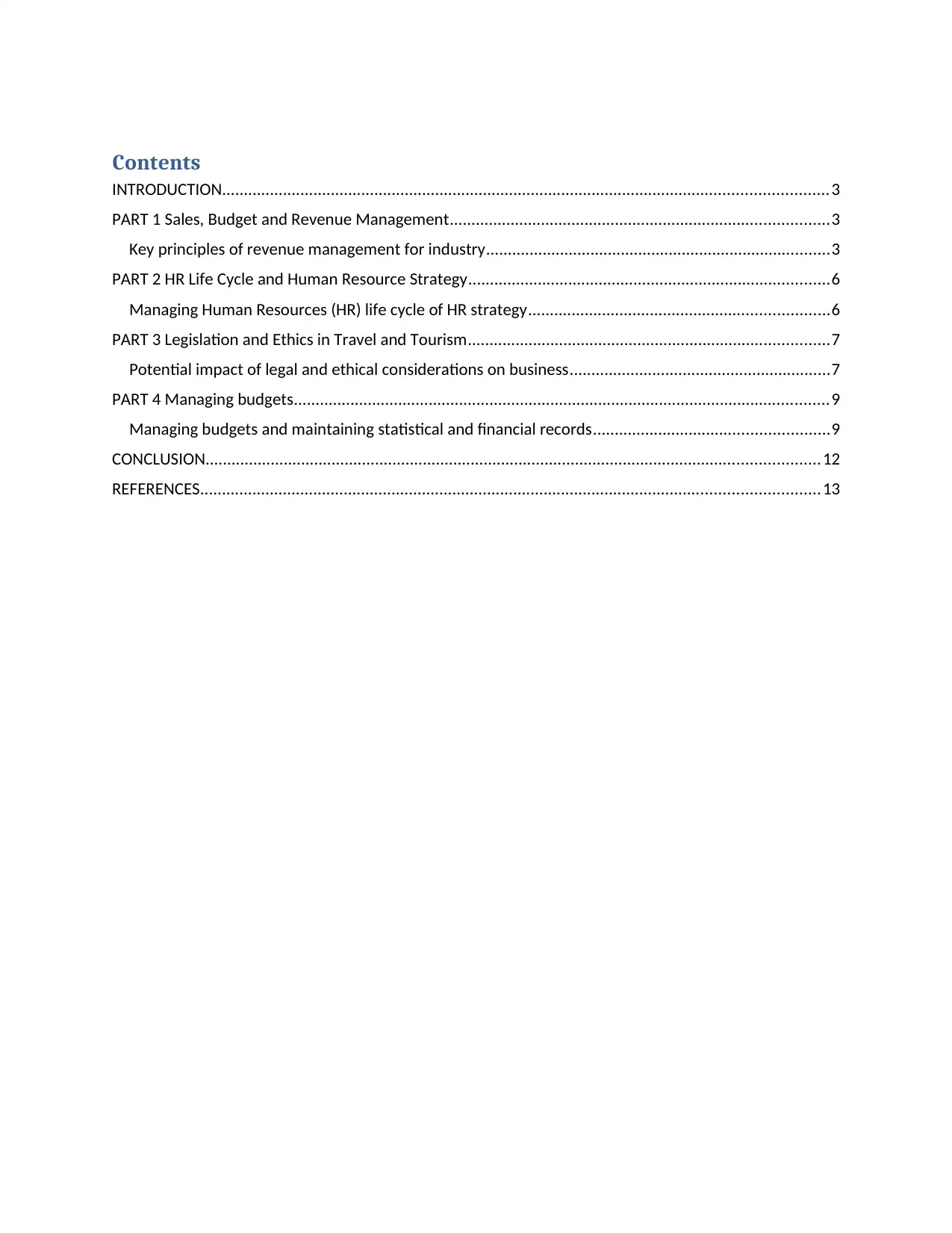
Contents
INTRODUCTION...........................................................................................................................................3
PART 1 Sales, Budget and Revenue Management.......................................................................................3
Key principles of revenue management for industry...............................................................................3
PART 2 HR Life Cycle and Human Resource Strategy...................................................................................6
Managing Human Resources (HR) life cycle of HR strategy.....................................................................6
PART 3 Legislation and Ethics in Travel and Tourism...................................................................................7
Potential impact of legal and ethical considerations on business............................................................7
PART 4 Managing budgets...........................................................................................................................9
Managing budgets and maintaining statistical and financial records......................................................9
CONCLUSION.............................................................................................................................................12
REFERENCES..............................................................................................................................................13
INTRODUCTION...........................................................................................................................................3
PART 1 Sales, Budget and Revenue Management.......................................................................................3
Key principles of revenue management for industry...............................................................................3
PART 2 HR Life Cycle and Human Resource Strategy...................................................................................6
Managing Human Resources (HR) life cycle of HR strategy.....................................................................6
PART 3 Legislation and Ethics in Travel and Tourism...................................................................................7
Potential impact of legal and ethical considerations on business............................................................7
PART 4 Managing budgets...........................................................................................................................9
Managing budgets and maintaining statistical and financial records......................................................9
CONCLUSION.............................................................................................................................................12
REFERENCES..............................................................................................................................................13
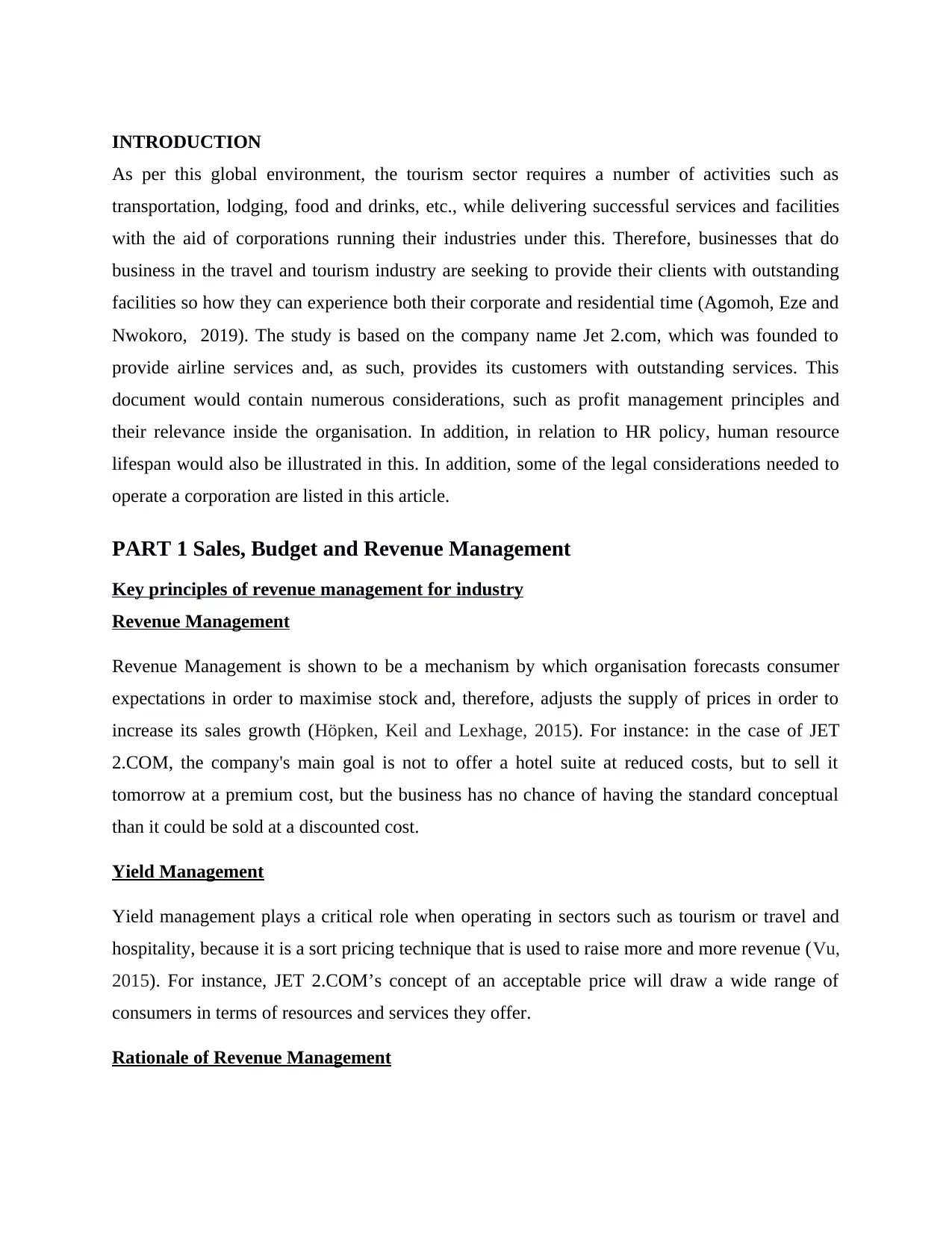
INTRODUCTION
As per this global environment, the tourism sector requires a number of activities such as
transportation, lodging, food and drinks, etc., while delivering successful services and facilities
with the aid of corporations running their industries under this. Therefore, businesses that do
business in the travel and tourism industry are seeking to provide their clients with outstanding
facilities so how they can experience both their corporate and residential time (Agomoh, Eze and
Nwokoro, 2019). The study is based on the company name Jet 2.com, which was founded to
provide airline services and, as such, provides its customers with outstanding services. This
document would contain numerous considerations, such as profit management principles and
their relevance inside the organisation. In addition, in relation to HR policy, human resource
lifespan would also be illustrated in this. In addition, some of the legal considerations needed to
operate a corporation are listed in this article.
PART 1 Sales, Budget and Revenue Management
Key principles of revenue management for industry
Revenue Management
Revenue Management is shown to be a mechanism by which organisation forecasts consumer
expectations in order to maximise stock and, therefore, adjusts the supply of prices in order to
increase its sales growth (Höpken, Keil and Lexhage, 2015). For instance: in the case of JET
2.COM, the company's main goal is not to offer a hotel suite at reduced costs, but to sell it
tomorrow at a premium cost, but the business has no chance of having the standard conceptual
than it could be sold at a discounted cost.
Yield Management
Yield management plays a critical role when operating in sectors such as tourism or travel and
hospitality, because it is a sort pricing technique that is used to raise more and more revenue (Vu,
2015). For instance, JET 2.COM’s concept of an acceptable price will draw a wide range of
consumers in terms of resources and services they offer.
Rationale of Revenue Management
As per this global environment, the tourism sector requires a number of activities such as
transportation, lodging, food and drinks, etc., while delivering successful services and facilities
with the aid of corporations running their industries under this. Therefore, businesses that do
business in the travel and tourism industry are seeking to provide their clients with outstanding
facilities so how they can experience both their corporate and residential time (Agomoh, Eze and
Nwokoro, 2019). The study is based on the company name Jet 2.com, which was founded to
provide airline services and, as such, provides its customers with outstanding services. This
document would contain numerous considerations, such as profit management principles and
their relevance inside the organisation. In addition, in relation to HR policy, human resource
lifespan would also be illustrated in this. In addition, some of the legal considerations needed to
operate a corporation are listed in this article.
PART 1 Sales, Budget and Revenue Management
Key principles of revenue management for industry
Revenue Management
Revenue Management is shown to be a mechanism by which organisation forecasts consumer
expectations in order to maximise stock and, therefore, adjusts the supply of prices in order to
increase its sales growth (Höpken, Keil and Lexhage, 2015). For instance: in the case of JET
2.COM, the company's main goal is not to offer a hotel suite at reduced costs, but to sell it
tomorrow at a premium cost, but the business has no chance of having the standard conceptual
than it could be sold at a discounted cost.
Yield Management
Yield management plays a critical role when operating in sectors such as tourism or travel and
hospitality, because it is a sort pricing technique that is used to raise more and more revenue (Vu,
2015). For instance, JET 2.COM’s concept of an acceptable price will draw a wide range of
consumers in terms of resources and services they offer.
Rationale of Revenue Management
⊘ This is a preview!⊘
Do you want full access?
Subscribe today to unlock all pages.

Trusted by 1+ million students worldwide
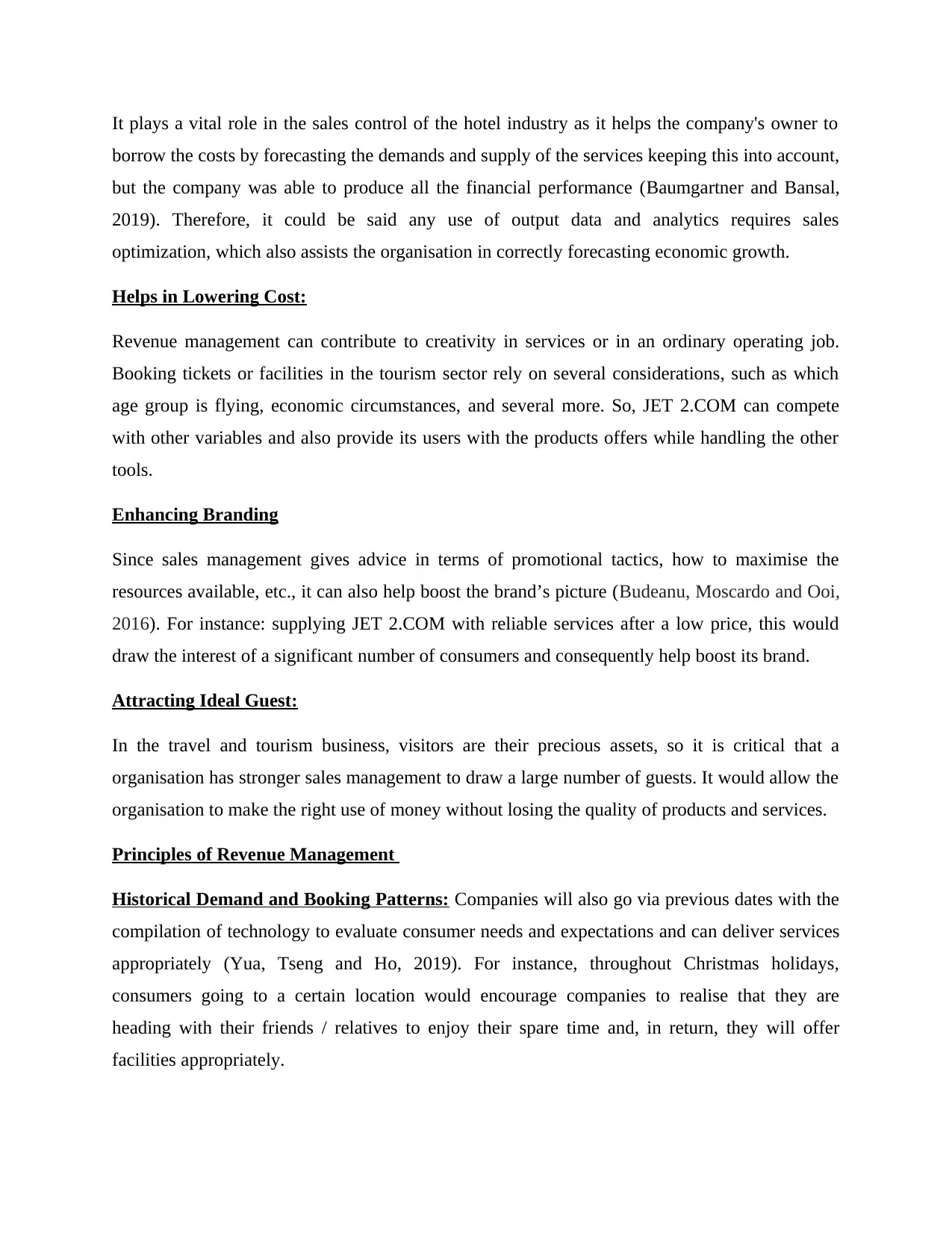
It plays a vital role in the sales control of the hotel industry as it helps the company's owner to
borrow the costs by forecasting the demands and supply of the services keeping this into account,
but the company was able to produce all the financial performance (Baumgartner and Bansal,
2019). Therefore, it could be said any use of output data and analytics requires sales
optimization, which also assists the organisation in correctly forecasting economic growth.
Helps in Lowering Cost:
Revenue management can contribute to creativity in services or in an ordinary operating job.
Booking tickets or facilities in the tourism sector rely on several considerations, such as which
age group is flying, economic circumstances, and several more. So, JET 2.COM can compete
with other variables and also provide its users with the products offers while handling the other
tools.
Enhancing Branding
Since sales management gives advice in terms of promotional tactics, how to maximise the
resources available, etc., it can also help boost the brand’s picture (Budeanu, Moscardo and Ooi,
2016). For instance: supplying JET 2.COM with reliable services after a low price, this would
draw the interest of a significant number of consumers and consequently help boost its brand.
Attracting Ideal Guest:
In the travel and tourism business, visitors are their precious assets, so it is critical that a
organisation has stronger sales management to draw a large number of guests. It would allow the
organisation to make the right use of money without losing the quality of products and services.
Principles of Revenue Management
Historical Demand and Booking Patterns: Companies will also go via previous dates with the
compilation of technology to evaluate consumer needs and expectations and can deliver services
appropriately (Yua, Tseng and Ho, 2019). For instance, throughout Christmas holidays,
consumers going to a certain location would encourage companies to realise that they are
heading with their friends / relatives to enjoy their spare time and, in return, they will offer
facilities appropriately.
borrow the costs by forecasting the demands and supply of the services keeping this into account,
but the company was able to produce all the financial performance (Baumgartner and Bansal,
2019). Therefore, it could be said any use of output data and analytics requires sales
optimization, which also assists the organisation in correctly forecasting economic growth.
Helps in Lowering Cost:
Revenue management can contribute to creativity in services or in an ordinary operating job.
Booking tickets or facilities in the tourism sector rely on several considerations, such as which
age group is flying, economic circumstances, and several more. So, JET 2.COM can compete
with other variables and also provide its users with the products offers while handling the other
tools.
Enhancing Branding
Since sales management gives advice in terms of promotional tactics, how to maximise the
resources available, etc., it can also help boost the brand’s picture (Budeanu, Moscardo and Ooi,
2016). For instance: supplying JET 2.COM with reliable services after a low price, this would
draw the interest of a significant number of consumers and consequently help boost its brand.
Attracting Ideal Guest:
In the travel and tourism business, visitors are their precious assets, so it is critical that a
organisation has stronger sales management to draw a large number of guests. It would allow the
organisation to make the right use of money without losing the quality of products and services.
Principles of Revenue Management
Historical Demand and Booking Patterns: Companies will also go via previous dates with the
compilation of technology to evaluate consumer needs and expectations and can deliver services
appropriately (Yua, Tseng and Ho, 2019). For instance, throughout Christmas holidays,
consumers going to a certain location would encourage companies to realise that they are
heading with their friends / relatives to enjoy their spare time and, in return, they will offer
facilities appropriately.
Paraphrase This Document
Need a fresh take? Get an instant paraphrase of this document with our AI Paraphraser
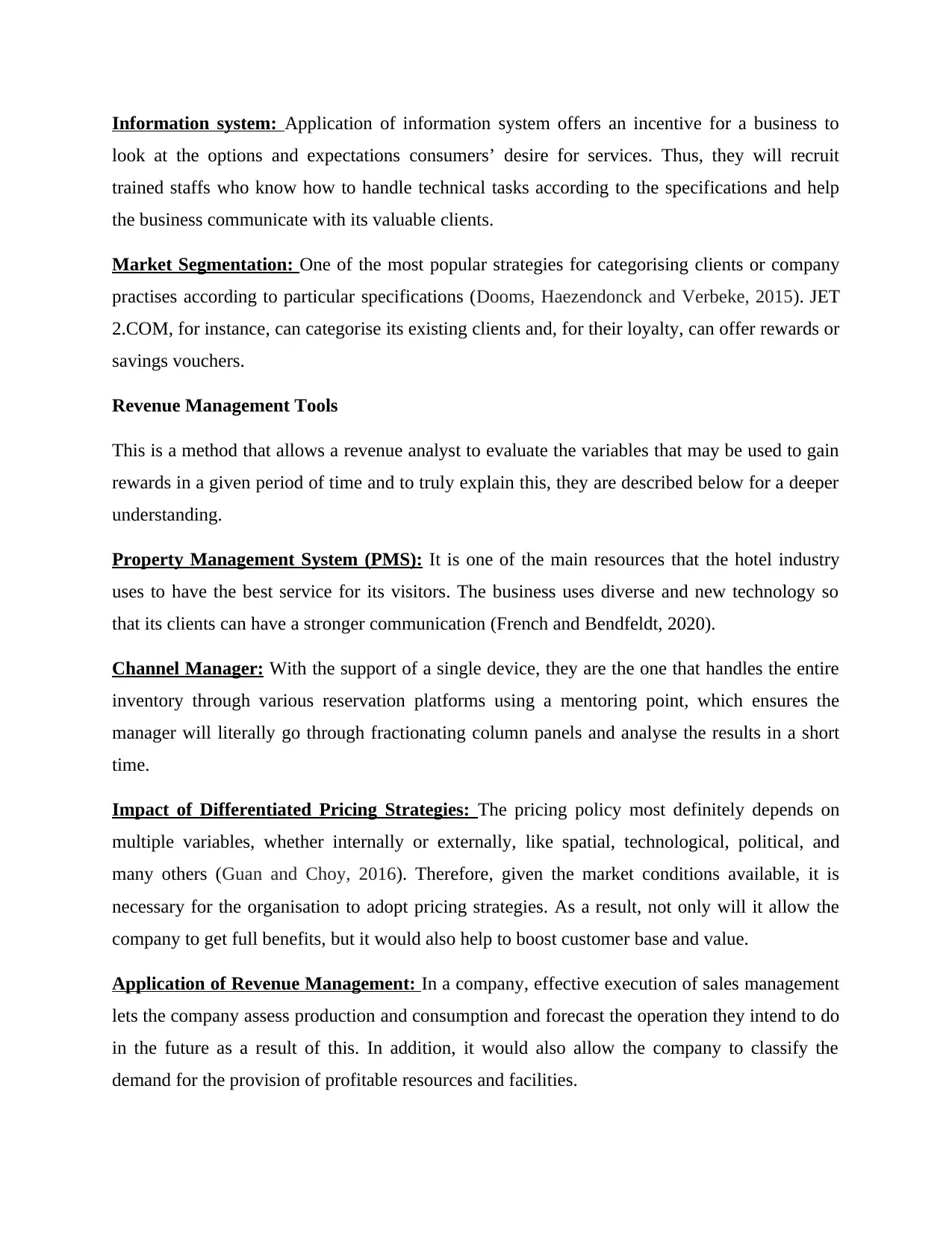
Information system: Application of information system offers an incentive for a business to
look at the options and expectations consumers’ desire for services. Thus, they will recruit
trained staffs who know how to handle technical tasks according to the specifications and help
the business communicate with its valuable clients.
Market Segmentation: One of the most popular strategies for categorising clients or company
practises according to particular specifications (Dooms, Haezendonck and Verbeke, 2015). JET
2.COM, for instance, can categorise its existing clients and, for their loyalty, can offer rewards or
savings vouchers.
Revenue Management Tools
This is a method that allows a revenue analyst to evaluate the variables that may be used to gain
rewards in a given period of time and to truly explain this, they are described below for a deeper
understanding.
Property Management System (PMS): It is one of the main resources that the hotel industry
uses to have the best service for its visitors. The business uses diverse and new technology so
that its clients can have a stronger communication (French and Bendfeldt, 2020).
Channel Manager: With the support of a single device, they are the one that handles the entire
inventory through various reservation platforms using a mentoring point, which ensures the
manager will literally go through fractionating column panels and analyse the results in a short
time.
Impact of Differentiated Pricing Strategies: The pricing policy most definitely depends on
multiple variables, whether internally or externally, like spatial, technological, political, and
many others (Guan and Choy, 2016). Therefore, given the market conditions available, it is
necessary for the organisation to adopt pricing strategies. As a result, not only will it allow the
company to get full benefits, but it would also help to boost customer base and value.
Application of Revenue Management: In a company, effective execution of sales management
lets the company assess production and consumption and forecast the operation they intend to do
in the future as a result of this. In addition, it would also allow the company to classify the
demand for the provision of profitable resources and facilities.
look at the options and expectations consumers’ desire for services. Thus, they will recruit
trained staffs who know how to handle technical tasks according to the specifications and help
the business communicate with its valuable clients.
Market Segmentation: One of the most popular strategies for categorising clients or company
practises according to particular specifications (Dooms, Haezendonck and Verbeke, 2015). JET
2.COM, for instance, can categorise its existing clients and, for their loyalty, can offer rewards or
savings vouchers.
Revenue Management Tools
This is a method that allows a revenue analyst to evaluate the variables that may be used to gain
rewards in a given period of time and to truly explain this, they are described below for a deeper
understanding.
Property Management System (PMS): It is one of the main resources that the hotel industry
uses to have the best service for its visitors. The business uses diverse and new technology so
that its clients can have a stronger communication (French and Bendfeldt, 2020).
Channel Manager: With the support of a single device, they are the one that handles the entire
inventory through various reservation platforms using a mentoring point, which ensures the
manager will literally go through fractionating column panels and analyse the results in a short
time.
Impact of Differentiated Pricing Strategies: The pricing policy most definitely depends on
multiple variables, whether internally or externally, like spatial, technological, political, and
many others (Guan and Choy, 2016). Therefore, given the market conditions available, it is
necessary for the organisation to adopt pricing strategies. As a result, not only will it allow the
company to get full benefits, but it would also help to boost customer base and value.
Application of Revenue Management: In a company, effective execution of sales management
lets the company assess production and consumption and forecast the operation they intend to do
in the future as a result of this. In addition, it would also allow the company to classify the
demand for the provision of profitable resources and facilities.
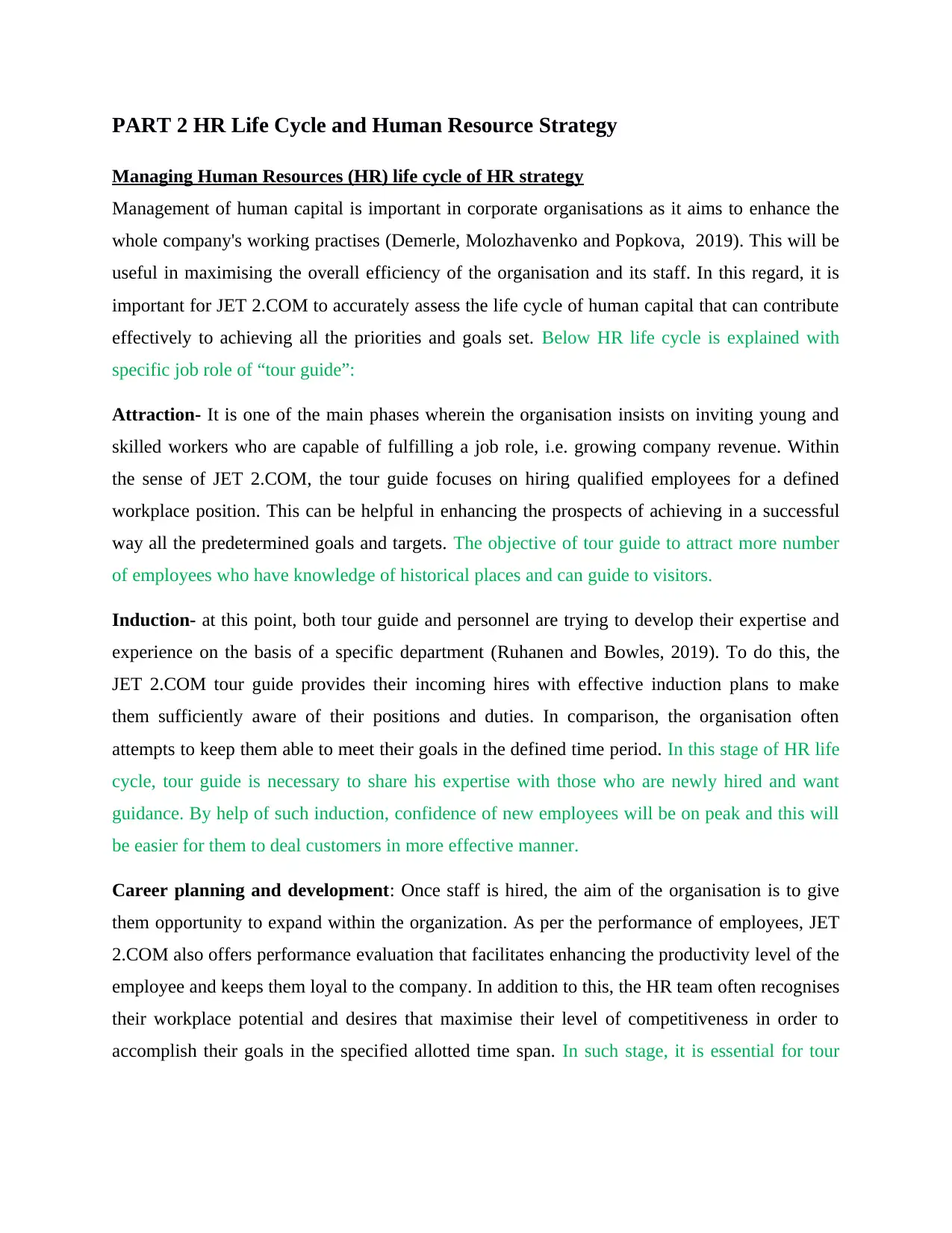
PART 2 HR Life Cycle and Human Resource Strategy
Managing Human Resources (HR) life cycle of HR strategy
Management of human capital is important in corporate organisations as it aims to enhance the
whole company's working practises (Demerle, Molozhavenko and Popkova, 2019). This will be
useful in maximising the overall efficiency of the organisation and its staff. In this regard, it is
important for JET 2.COM to accurately assess the life cycle of human capital that can contribute
effectively to achieving all the priorities and goals set. Below HR life cycle is explained with
specific job role of “tour guide”:
Attraction- It is one of the main phases wherein the organisation insists on inviting young and
skilled workers who are capable of fulfilling a job role, i.e. growing company revenue. Within
the sense of JET 2.COM, the tour guide focuses on hiring qualified employees for a defined
workplace position. This can be helpful in enhancing the prospects of achieving in a successful
way all the predetermined goals and targets. The objective of tour guide to attract more number
of employees who have knowledge of historical places and can guide to visitors.
Induction- at this point, both tour guide and personnel are trying to develop their expertise and
experience on the basis of a specific department (Ruhanen and Bowles, 2019). To do this, the
JET 2.COM tour guide provides their incoming hires with effective induction plans to make
them sufficiently aware of their positions and duties. In comparison, the organisation often
attempts to keep them able to meet their goals in the defined time period. In this stage of HR life
cycle, tour guide is necessary to share his expertise with those who are newly hired and want
guidance. By help of such induction, confidence of new employees will be on peak and this will
be easier for them to deal customers in more effective manner.
Career planning and development: Once staff is hired, the aim of the organisation is to give
them opportunity to expand within the organization. As per the performance of employees, JET
2.COM also offers performance evaluation that facilitates enhancing the productivity level of the
employee and keeps them loyal to the company. In addition to this, the HR team often recognises
their workplace potential and desires that maximise their level of competitiveness in order to
accomplish their goals in the specified allotted time span. In such stage, it is essential for tour
Managing Human Resources (HR) life cycle of HR strategy
Management of human capital is important in corporate organisations as it aims to enhance the
whole company's working practises (Demerle, Molozhavenko and Popkova, 2019). This will be
useful in maximising the overall efficiency of the organisation and its staff. In this regard, it is
important for JET 2.COM to accurately assess the life cycle of human capital that can contribute
effectively to achieving all the priorities and goals set. Below HR life cycle is explained with
specific job role of “tour guide”:
Attraction- It is one of the main phases wherein the organisation insists on inviting young and
skilled workers who are capable of fulfilling a job role, i.e. growing company revenue. Within
the sense of JET 2.COM, the tour guide focuses on hiring qualified employees for a defined
workplace position. This can be helpful in enhancing the prospects of achieving in a successful
way all the predetermined goals and targets. The objective of tour guide to attract more number
of employees who have knowledge of historical places and can guide to visitors.
Induction- at this point, both tour guide and personnel are trying to develop their expertise and
experience on the basis of a specific department (Ruhanen and Bowles, 2019). To do this, the
JET 2.COM tour guide provides their incoming hires with effective induction plans to make
them sufficiently aware of their positions and duties. In comparison, the organisation often
attempts to keep them able to meet their goals in the defined time period. In this stage of HR life
cycle, tour guide is necessary to share his expertise with those who are newly hired and want
guidance. By help of such induction, confidence of new employees will be on peak and this will
be easier for them to deal customers in more effective manner.
Career planning and development: Once staff is hired, the aim of the organisation is to give
them opportunity to expand within the organization. As per the performance of employees, JET
2.COM also offers performance evaluation that facilitates enhancing the productivity level of the
employee and keeps them loyal to the company. In addition to this, the HR team often recognises
their workplace potential and desires that maximise their level of competitiveness in order to
accomplish their goals in the specified allotted time span. In such stage, it is essential for tour
⊘ This is a preview!⊘
Do you want full access?
Subscribe today to unlock all pages.

Trusted by 1+ million students worldwide
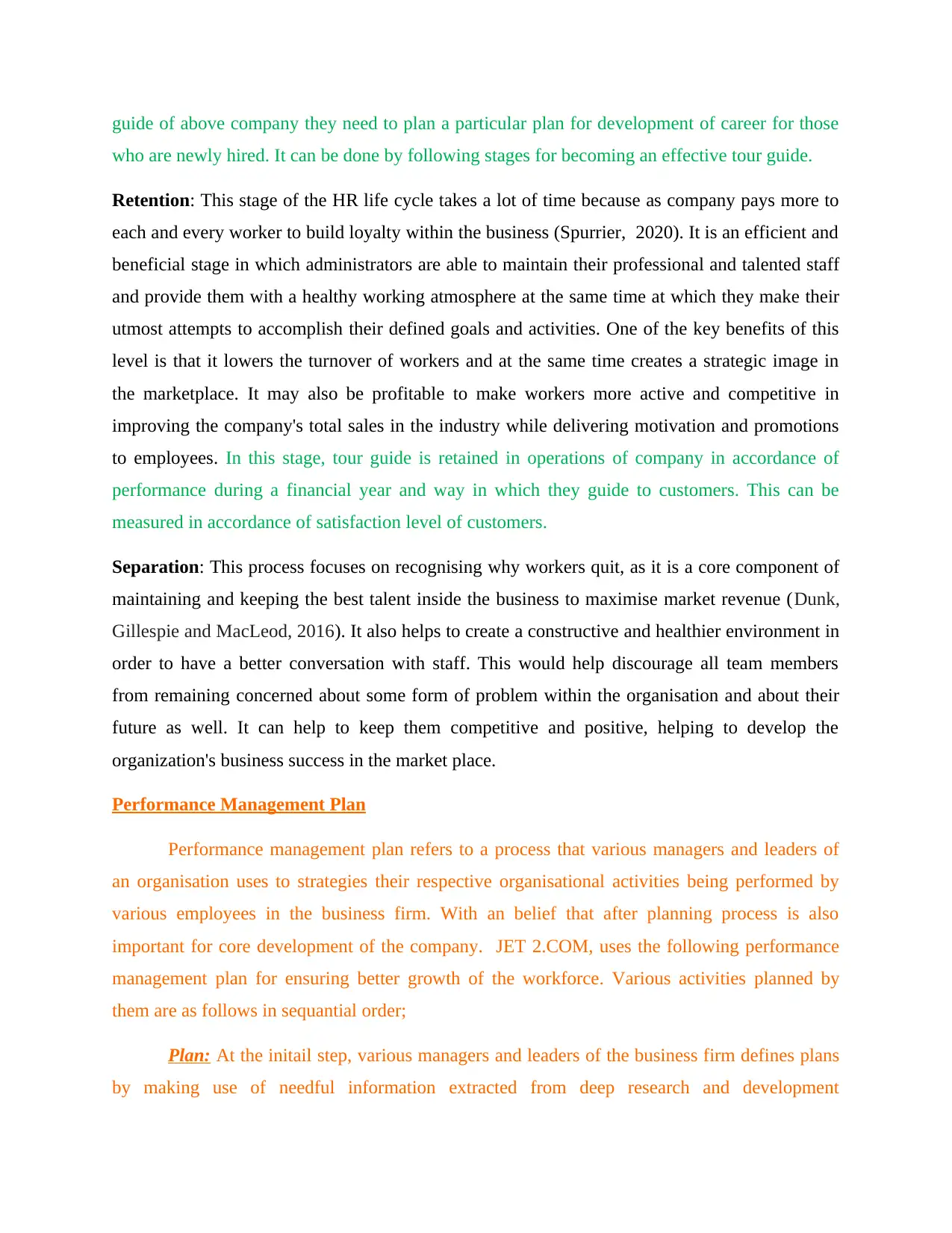
guide of above company they need to plan a particular plan for development of career for those
who are newly hired. It can be done by following stages for becoming an effective tour guide.
Retention: This stage of the HR life cycle takes a lot of time because as company pays more to
each and every worker to build loyalty within the business (Spurrier, 2020). It is an efficient and
beneficial stage in which administrators are able to maintain their professional and talented staff
and provide them with a healthy working atmosphere at the same time at which they make their
utmost attempts to accomplish their defined goals and activities. One of the key benefits of this
level is that it lowers the turnover of workers and at the same time creates a strategic image in
the marketplace. It may also be profitable to make workers more active and competitive in
improving the company's total sales in the industry while delivering motivation and promotions
to employees. In this stage, tour guide is retained in operations of company in accordance of
performance during a financial year and way in which they guide to customers. This can be
measured in accordance of satisfaction level of customers.
Separation: This process focuses on recognising why workers quit, as it is a core component of
maintaining and keeping the best talent inside the business to maximise market revenue (Dunk,
Gillespie and MacLeod, 2016). It also helps to create a constructive and healthier environment in
order to have a better conversation with staff. This would help discourage all team members
from remaining concerned about some form of problem within the organisation and about their
future as well. It can help to keep them competitive and positive, helping to develop the
organization's business success in the market place.
Performance Management Plan
Performance management plan refers to a process that various managers and leaders of
an organisation uses to strategies their respective organisational activities being performed by
various employees in the business firm. With an belief that after planning process is also
important for core development of the company. JET 2.COM, uses the following performance
management plan for ensuring better growth of the workforce. Various activities planned by
them are as follows in sequantial order;
Plan: At the initail step, various managers and leaders of the business firm defines plans
by making use of needful information extracted from deep research and development
who are newly hired. It can be done by following stages for becoming an effective tour guide.
Retention: This stage of the HR life cycle takes a lot of time because as company pays more to
each and every worker to build loyalty within the business (Spurrier, 2020). It is an efficient and
beneficial stage in which administrators are able to maintain their professional and talented staff
and provide them with a healthy working atmosphere at the same time at which they make their
utmost attempts to accomplish their defined goals and activities. One of the key benefits of this
level is that it lowers the turnover of workers and at the same time creates a strategic image in
the marketplace. It may also be profitable to make workers more active and competitive in
improving the company's total sales in the industry while delivering motivation and promotions
to employees. In this stage, tour guide is retained in operations of company in accordance of
performance during a financial year and way in which they guide to customers. This can be
measured in accordance of satisfaction level of customers.
Separation: This process focuses on recognising why workers quit, as it is a core component of
maintaining and keeping the best talent inside the business to maximise market revenue (Dunk,
Gillespie and MacLeod, 2016). It also helps to create a constructive and healthier environment in
order to have a better conversation with staff. This would help discourage all team members
from remaining concerned about some form of problem within the organisation and about their
future as well. It can help to keep them competitive and positive, helping to develop the
organization's business success in the market place.
Performance Management Plan
Performance management plan refers to a process that various managers and leaders of
an organisation uses to strategies their respective organisational activities being performed by
various employees in the business firm. With an belief that after planning process is also
important for core development of the company. JET 2.COM, uses the following performance
management plan for ensuring better growth of the workforce. Various activities planned by
them are as follows in sequantial order;
Plan: At the initail step, various managers and leaders of the business firm defines plans
by making use of needful information extracted from deep research and development
Paraphrase This Document
Need a fresh take? Get an instant paraphrase of this document with our AI Paraphraser
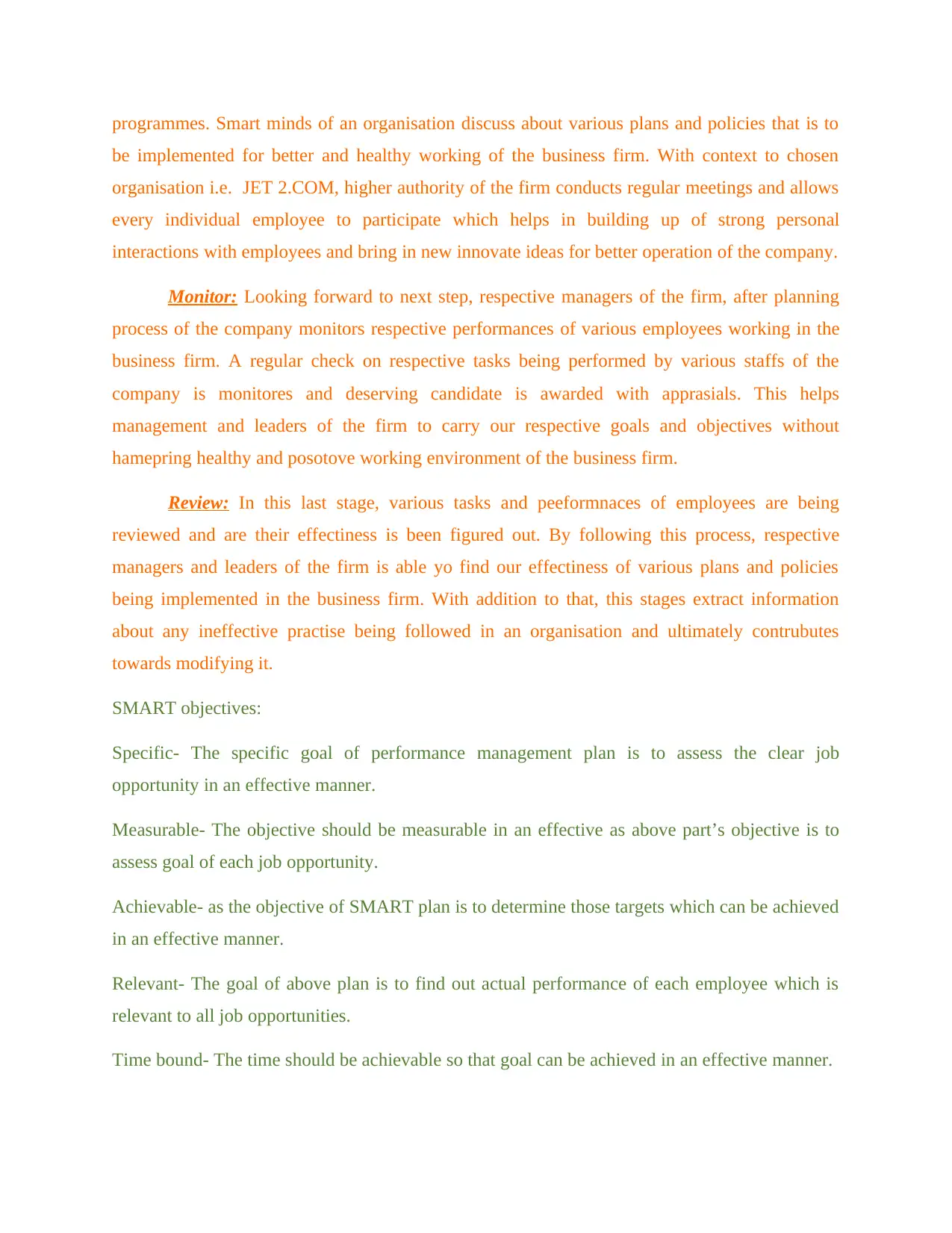
programmes. Smart minds of an organisation discuss about various plans and policies that is to
be implemented for better and healthy working of the business firm. With context to chosen
organisation i.e. JET 2.COM, higher authority of the firm conducts regular meetings and allows
every individual employee to participate which helps in building up of strong personal
interactions with employees and bring in new innovate ideas for better operation of the company.
Monitor: Looking forward to next step, respective managers of the firm, after planning
process of the company monitors respective performances of various employees working in the
business firm. A regular check on respective tasks being performed by various staffs of the
company is monitores and deserving candidate is awarded with apprasials. This helps
management and leaders of the firm to carry our respective goals and objectives without
hamepring healthy and posotove working environment of the business firm.
Review: In this last stage, various tasks and peeformnaces of employees are being
reviewed and are their effectiness is been figured out. By following this process, respective
managers and leaders of the firm is able yo find our effectiness of various plans and policies
being implemented in the business firm. With addition to that, this stages extract information
about any ineffective practise being followed in an organisation and ultimately contrubutes
towards modifying it.
SMART objectives:
Specific- The specific goal of performance management plan is to assess the clear job
opportunity in an effective manner.
Measurable- The objective should be measurable in an effective as above part’s objective is to
assess goal of each job opportunity.
Achievable- as the objective of SMART plan is to determine those targets which can be achieved
in an effective manner.
Relevant- The goal of above plan is to find out actual performance of each employee which is
relevant to all job opportunities.
Time bound- The time should be achievable so that goal can be achieved in an effective manner.
be implemented for better and healthy working of the business firm. With context to chosen
organisation i.e. JET 2.COM, higher authority of the firm conducts regular meetings and allows
every individual employee to participate which helps in building up of strong personal
interactions with employees and bring in new innovate ideas for better operation of the company.
Monitor: Looking forward to next step, respective managers of the firm, after planning
process of the company monitors respective performances of various employees working in the
business firm. A regular check on respective tasks being performed by various staffs of the
company is monitores and deserving candidate is awarded with apprasials. This helps
management and leaders of the firm to carry our respective goals and objectives without
hamepring healthy and posotove working environment of the business firm.
Review: In this last stage, various tasks and peeformnaces of employees are being
reviewed and are their effectiness is been figured out. By following this process, respective
managers and leaders of the firm is able yo find our effectiness of various plans and policies
being implemented in the business firm. With addition to that, this stages extract information
about any ineffective practise being followed in an organisation and ultimately contrubutes
towards modifying it.
SMART objectives:
Specific- The specific goal of performance management plan is to assess the clear job
opportunity in an effective manner.
Measurable- The objective should be measurable in an effective as above part’s objective is to
assess goal of each job opportunity.
Achievable- as the objective of SMART plan is to determine those targets which can be achieved
in an effective manner.
Relevant- The goal of above plan is to find out actual performance of each employee which is
relevant to all job opportunities.
Time bound- The time should be achievable so that goal can be achieved in an effective manner.
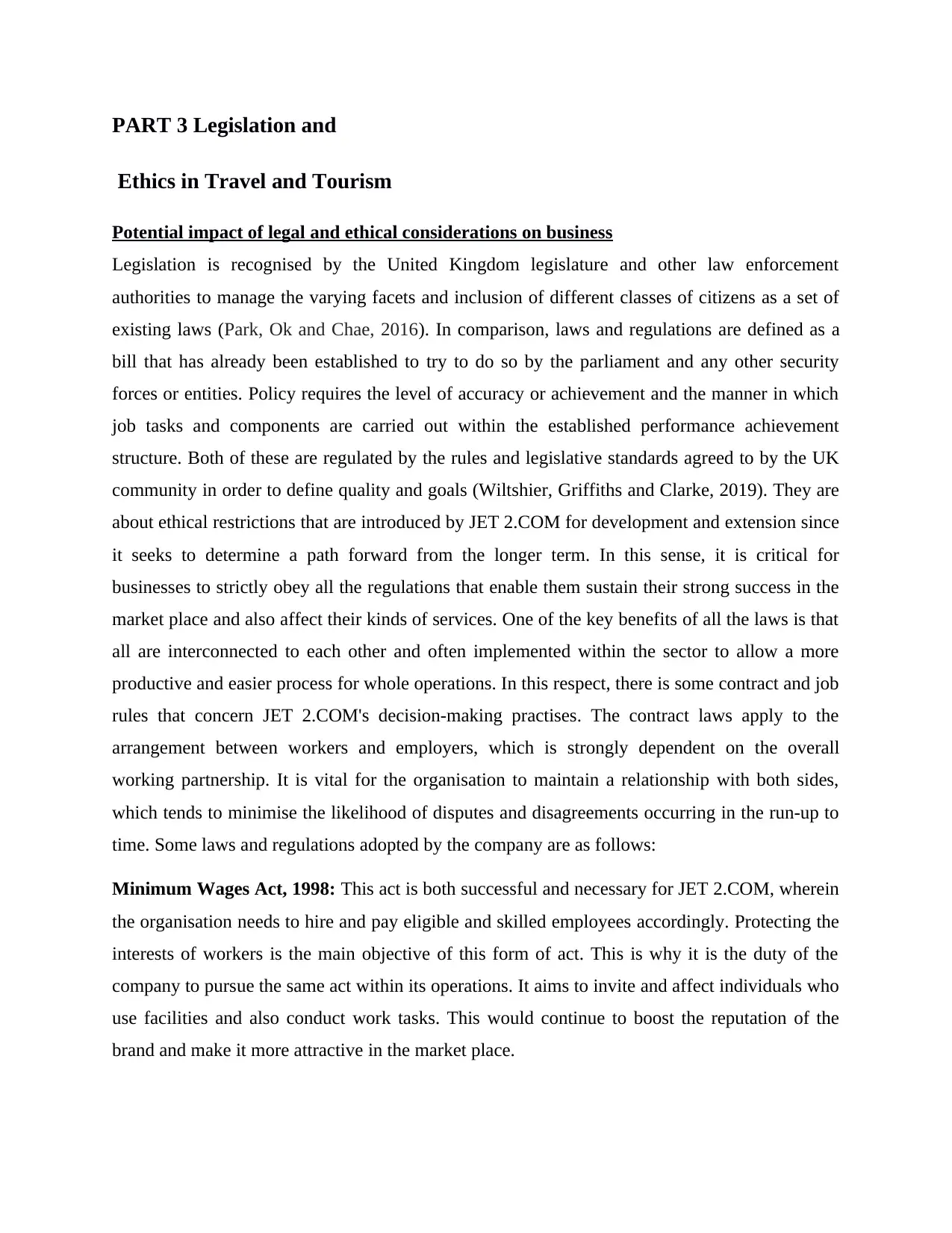
PART 3 Legislation and
Ethics in Travel and Tourism
Potential impact of legal and ethical considerations on business
Legislation is recognised by the United Kingdom legislature and other law enforcement
authorities to manage the varying facets and inclusion of different classes of citizens as a set of
existing laws (Park, Ok and Chae, 2016). In comparison, laws and regulations are defined as a
bill that has already been established to try to do so by the parliament and any other security
forces or entities. Policy requires the level of accuracy or achievement and the manner in which
job tasks and components are carried out within the established performance achievement
structure. Both of these are regulated by the rules and legislative standards agreed to by the UK
community in order to define quality and goals (Wiltshier, Griffiths and Clarke, 2019). They are
about ethical restrictions that are introduced by JET 2.COM for development and extension since
it seeks to determine a path forward from the longer term. In this sense, it is critical for
businesses to strictly obey all the regulations that enable them sustain their strong success in the
market place and also affect their kinds of services. One of the key benefits of all the laws is that
all are interconnected to each other and often implemented within the sector to allow a more
productive and easier process for whole operations. In this respect, there is some contract and job
rules that concern JET 2.COM's decision-making practises. The contract laws apply to the
arrangement between workers and employers, which is strongly dependent on the overall
working partnership. It is vital for the organisation to maintain a relationship with both sides,
which tends to minimise the likelihood of disputes and disagreements occurring in the run-up to
time. Some laws and regulations adopted by the company are as follows:
Minimum Wages Act, 1998: This act is both successful and necessary for JET 2.COM, wherein
the organisation needs to hire and pay eligible and skilled employees accordingly. Protecting the
interests of workers is the main objective of this form of act. This is why it is the duty of the
company to pursue the same act within its operations. It aims to invite and affect individuals who
use facilities and also conduct work tasks. This would continue to boost the reputation of the
brand and make it more attractive in the market place.
Ethics in Travel and Tourism
Potential impact of legal and ethical considerations on business
Legislation is recognised by the United Kingdom legislature and other law enforcement
authorities to manage the varying facets and inclusion of different classes of citizens as a set of
existing laws (Park, Ok and Chae, 2016). In comparison, laws and regulations are defined as a
bill that has already been established to try to do so by the parliament and any other security
forces or entities. Policy requires the level of accuracy or achievement and the manner in which
job tasks and components are carried out within the established performance achievement
structure. Both of these are regulated by the rules and legislative standards agreed to by the UK
community in order to define quality and goals (Wiltshier, Griffiths and Clarke, 2019). They are
about ethical restrictions that are introduced by JET 2.COM for development and extension since
it seeks to determine a path forward from the longer term. In this sense, it is critical for
businesses to strictly obey all the regulations that enable them sustain their strong success in the
market place and also affect their kinds of services. One of the key benefits of all the laws is that
all are interconnected to each other and often implemented within the sector to allow a more
productive and easier process for whole operations. In this respect, there is some contract and job
rules that concern JET 2.COM's decision-making practises. The contract laws apply to the
arrangement between workers and employers, which is strongly dependent on the overall
working partnership. It is vital for the organisation to maintain a relationship with both sides,
which tends to minimise the likelihood of disputes and disagreements occurring in the run-up to
time. Some laws and regulations adopted by the company are as follows:
Minimum Wages Act, 1998: This act is both successful and necessary for JET 2.COM, wherein
the organisation needs to hire and pay eligible and skilled employees accordingly. Protecting the
interests of workers is the main objective of this form of act. This is why it is the duty of the
company to pursue the same act within its operations. It aims to invite and affect individuals who
use facilities and also conduct work tasks. This would continue to boost the reputation of the
brand and make it more attractive in the market place.
⊘ This is a preview!⊘
Do you want full access?
Subscribe today to unlock all pages.

Trusted by 1+ million students worldwide
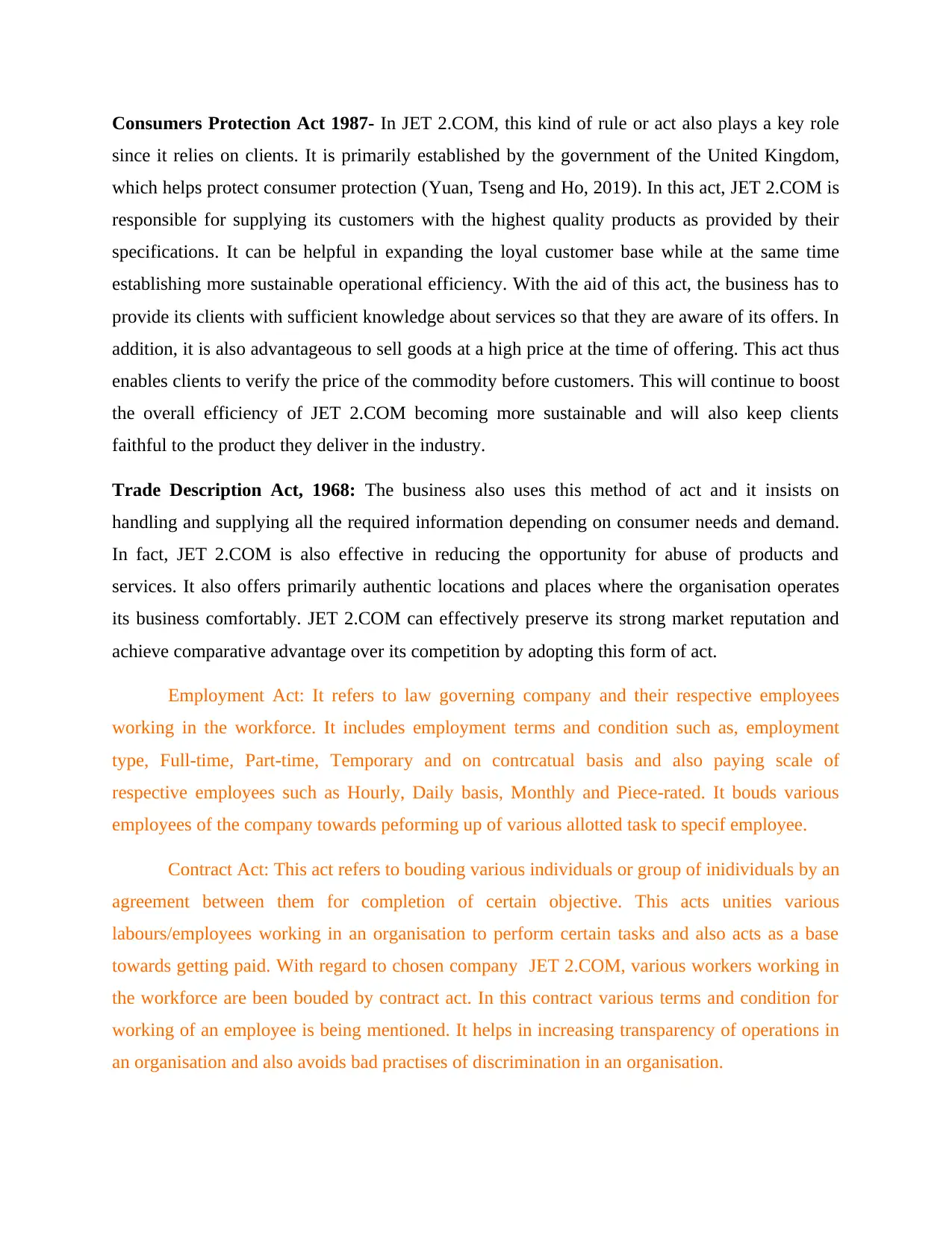
Consumers Protection Act 1987- In JET 2.COM, this kind of rule or act also plays a key role
since it relies on clients. It is primarily established by the government of the United Kingdom,
which helps protect consumer protection (Yuan, Tseng and Ho, 2019). In this act, JET 2.COM is
responsible for supplying its customers with the highest quality products as provided by their
specifications. It can be helpful in expanding the loyal customer base while at the same time
establishing more sustainable operational efficiency. With the aid of this act, the business has to
provide its clients with sufficient knowledge about services so that they are aware of its offers. In
addition, it is also advantageous to sell goods at a high price at the time of offering. This act thus
enables clients to verify the price of the commodity before customers. This will continue to boost
the overall efficiency of JET 2.COM becoming more sustainable and will also keep clients
faithful to the product they deliver in the industry.
Trade Description Act, 1968: The business also uses this method of act and it insists on
handling and supplying all the required information depending on consumer needs and demand.
In fact, JET 2.COM is also effective in reducing the opportunity for abuse of products and
services. It also offers primarily authentic locations and places where the organisation operates
its business comfortably. JET 2.COM can effectively preserve its strong market reputation and
achieve comparative advantage over its competition by adopting this form of act.
Employment Act: It refers to law governing company and their respective employees
working in the workforce. It includes employment terms and condition such as, employment
type, Full-time, Part-time, Temporary and on contrcatual basis and also paying scale of
respective employees such as Hourly, Daily basis, Monthly and Piece-rated. It bouds various
employees of the company towards peforming up of various allotted task to specif employee.
Contract Act: This act refers to bouding various individuals or group of inidividuals by an
agreement between them for completion of certain objective. This acts unities various
labours/employees working in an organisation to perform certain tasks and also acts as a base
towards getting paid. With regard to chosen company JET 2.COM, various workers working in
the workforce are been bouded by contract act. In this contract various terms and condition for
working of an employee is being mentioned. It helps in increasing transparency of operations in
an organisation and also avoids bad practises of discrimination in an organisation.
since it relies on clients. It is primarily established by the government of the United Kingdom,
which helps protect consumer protection (Yuan, Tseng and Ho, 2019). In this act, JET 2.COM is
responsible for supplying its customers with the highest quality products as provided by their
specifications. It can be helpful in expanding the loyal customer base while at the same time
establishing more sustainable operational efficiency. With the aid of this act, the business has to
provide its clients with sufficient knowledge about services so that they are aware of its offers. In
addition, it is also advantageous to sell goods at a high price at the time of offering. This act thus
enables clients to verify the price of the commodity before customers. This will continue to boost
the overall efficiency of JET 2.COM becoming more sustainable and will also keep clients
faithful to the product they deliver in the industry.
Trade Description Act, 1968: The business also uses this method of act and it insists on
handling and supplying all the required information depending on consumer needs and demand.
In fact, JET 2.COM is also effective in reducing the opportunity for abuse of products and
services. It also offers primarily authentic locations and places where the organisation operates
its business comfortably. JET 2.COM can effectively preserve its strong market reputation and
achieve comparative advantage over its competition by adopting this form of act.
Employment Act: It refers to law governing company and their respective employees
working in the workforce. It includes employment terms and condition such as, employment
type, Full-time, Part-time, Temporary and on contrcatual basis and also paying scale of
respective employees such as Hourly, Daily basis, Monthly and Piece-rated. It bouds various
employees of the company towards peforming up of various allotted task to specif employee.
Contract Act: This act refers to bouding various individuals or group of inidividuals by an
agreement between them for completion of certain objective. This acts unities various
labours/employees working in an organisation to perform certain tasks and also acts as a base
towards getting paid. With regard to chosen company JET 2.COM, various workers working in
the workforce are been bouded by contract act. In this contract various terms and condition for
working of an employee is being mentioned. It helps in increasing transparency of operations in
an organisation and also avoids bad practises of discrimination in an organisation.
Paraphrase This Document
Need a fresh take? Get an instant paraphrase of this document with our AI Paraphraser
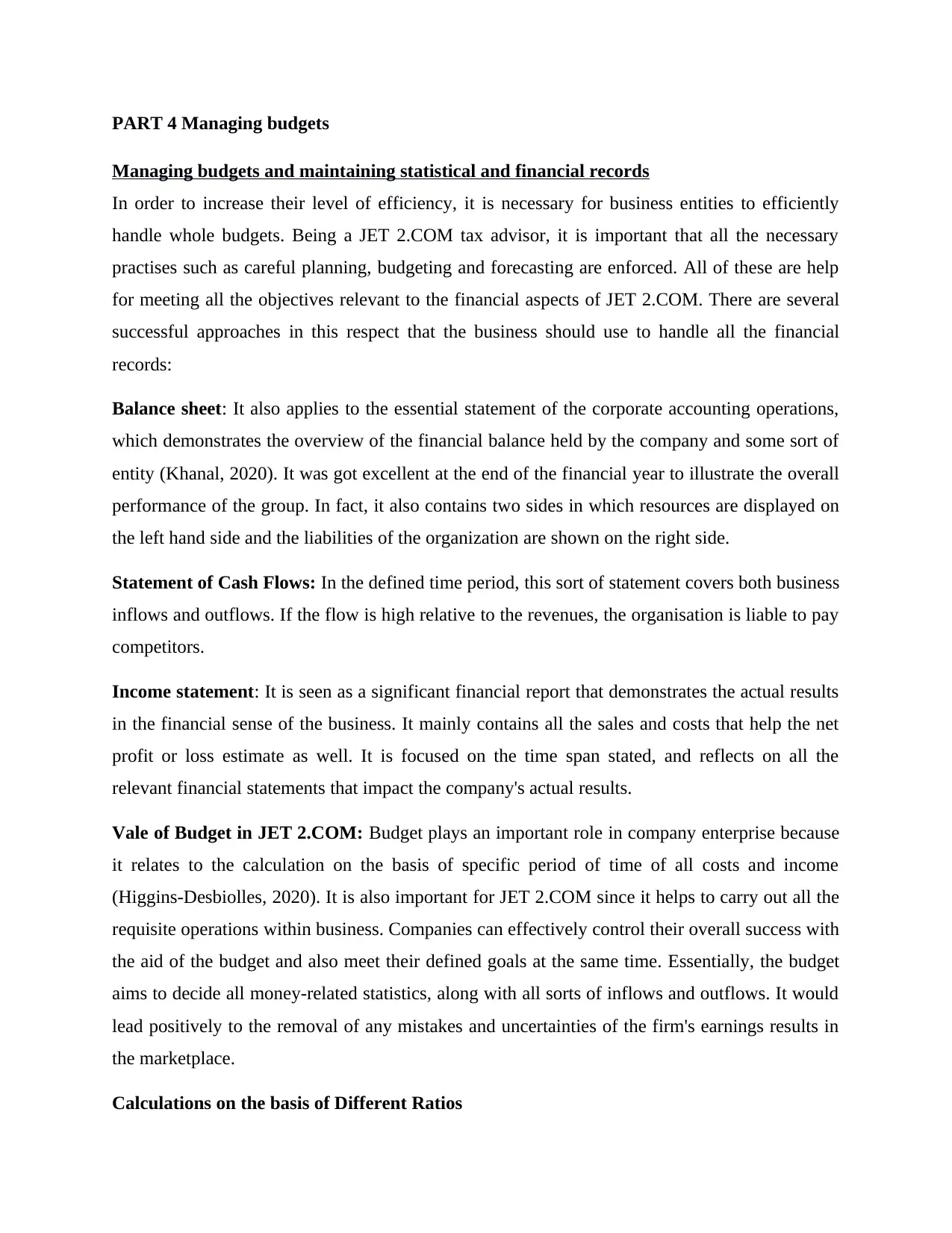
PART 4 Managing budgets
Managing budgets and maintaining statistical and financial records
In order to increase their level of efficiency, it is necessary for business entities to efficiently
handle whole budgets. Being a JET 2.COM tax advisor, it is important that all the necessary
practises such as careful planning, budgeting and forecasting are enforced. All of these are help
for meeting all the objectives relevant to the financial aspects of JET 2.COM. There are several
successful approaches in this respect that the business should use to handle all the financial
records:
Balance sheet: It also applies to the essential statement of the corporate accounting operations,
which demonstrates the overview of the financial balance held by the company and some sort of
entity (Khanal, 2020). It was got excellent at the end of the financial year to illustrate the overall
performance of the group. In fact, it also contains two sides in which resources are displayed on
the left hand side and the liabilities of the organization are shown on the right side.
Statement of Cash Flows: In the defined time period, this sort of statement covers both business
inflows and outflows. If the flow is high relative to the revenues, the organisation is liable to pay
competitors.
Income statement: It is seen as a significant financial report that demonstrates the actual results
in the financial sense of the business. It mainly contains all the sales and costs that help the net
profit or loss estimate as well. It is focused on the time span stated, and reflects on all the
relevant financial statements that impact the company's actual results.
Vale of Budget in JET 2.COM: Budget plays an important role in company enterprise because
it relates to the calculation on the basis of specific period of time of all costs and income
(Higgins-Desbiolles, 2020). It is also important for JET 2.COM since it helps to carry out all the
requisite operations within business. Companies can effectively control their overall success with
the aid of the budget and also meet their defined goals at the same time. Essentially, the budget
aims to decide all money-related statistics, along with all sorts of inflows and outflows. It would
lead positively to the removal of any mistakes and uncertainties of the firm's earnings results in
the marketplace.
Calculations on the basis of Different Ratios
Managing budgets and maintaining statistical and financial records
In order to increase their level of efficiency, it is necessary for business entities to efficiently
handle whole budgets. Being a JET 2.COM tax advisor, it is important that all the necessary
practises such as careful planning, budgeting and forecasting are enforced. All of these are help
for meeting all the objectives relevant to the financial aspects of JET 2.COM. There are several
successful approaches in this respect that the business should use to handle all the financial
records:
Balance sheet: It also applies to the essential statement of the corporate accounting operations,
which demonstrates the overview of the financial balance held by the company and some sort of
entity (Khanal, 2020). It was got excellent at the end of the financial year to illustrate the overall
performance of the group. In fact, it also contains two sides in which resources are displayed on
the left hand side and the liabilities of the organization are shown on the right side.
Statement of Cash Flows: In the defined time period, this sort of statement covers both business
inflows and outflows. If the flow is high relative to the revenues, the organisation is liable to pay
competitors.
Income statement: It is seen as a significant financial report that demonstrates the actual results
in the financial sense of the business. It mainly contains all the sales and costs that help the net
profit or loss estimate as well. It is focused on the time span stated, and reflects on all the
relevant financial statements that impact the company's actual results.
Vale of Budget in JET 2.COM: Budget plays an important role in company enterprise because
it relates to the calculation on the basis of specific period of time of all costs and income
(Higgins-Desbiolles, 2020). It is also important for JET 2.COM since it helps to carry out all the
requisite operations within business. Companies can effectively control their overall success with
the aid of the budget and also meet their defined goals at the same time. Essentially, the budget
aims to decide all money-related statistics, along with all sorts of inflows and outflows. It would
lead positively to the removal of any mistakes and uncertainties of the firm's earnings results in
the marketplace.
Calculations on the basis of Different Ratios
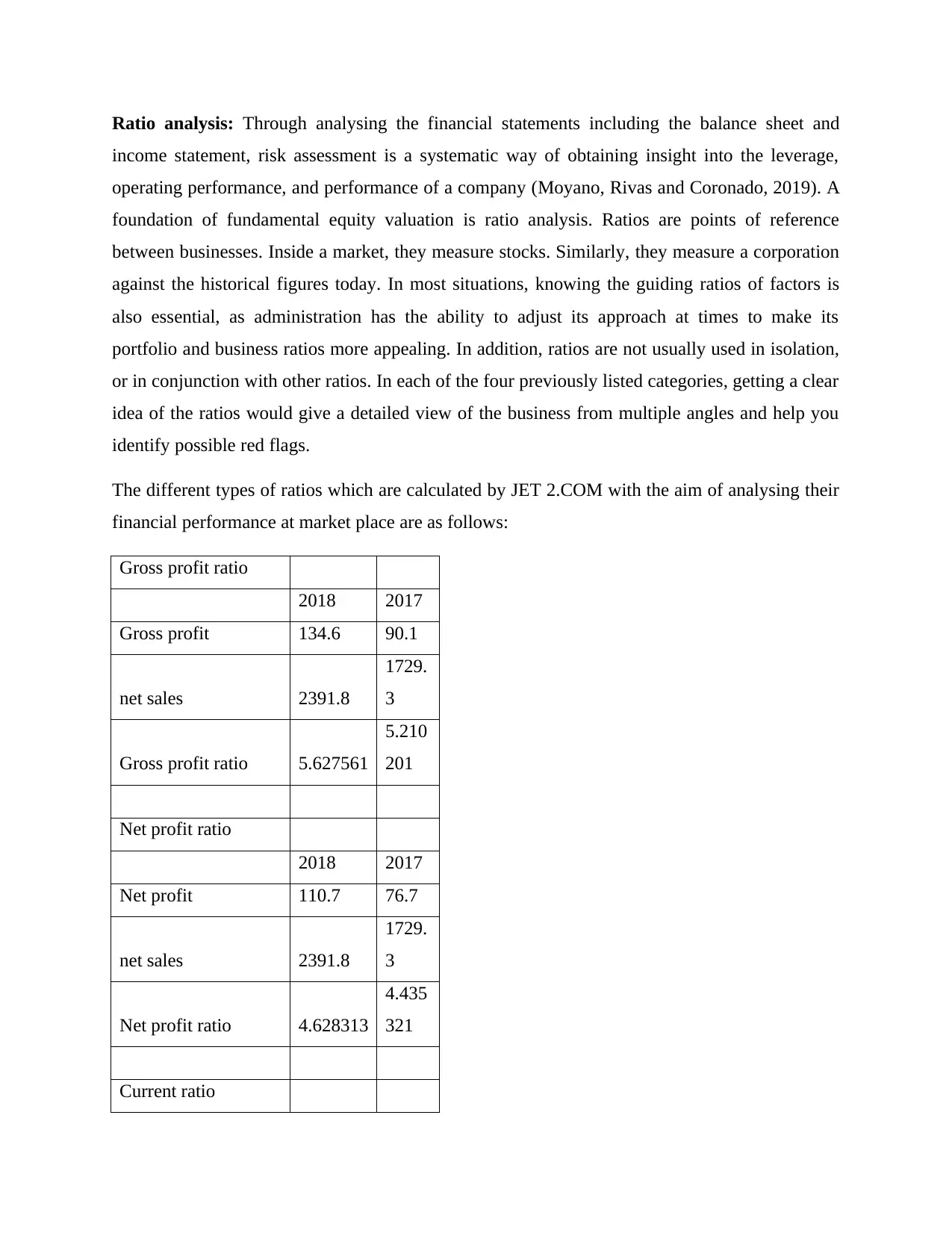
Ratio analysis: Through analysing the financial statements including the balance sheet and
income statement, risk assessment is a systematic way of obtaining insight into the leverage,
operating performance, and performance of a company (Moyano, Rivas and Coronado, 2019). A
foundation of fundamental equity valuation is ratio analysis. Ratios are points of reference
between businesses. Inside a market, they measure stocks. Similarly, they measure a corporation
against the historical figures today. In most situations, knowing the guiding ratios of factors is
also essential, as administration has the ability to adjust its approach at times to make its
portfolio and business ratios more appealing. In addition, ratios are not usually used in isolation,
or in conjunction with other ratios. In each of the four previously listed categories, getting a clear
idea of the ratios would give a detailed view of the business from multiple angles and help you
identify possible red flags.
The different types of ratios which are calculated by JET 2.COM with the aim of analysing their
financial performance at market place are as follows:
Gross profit ratio
2018 2017
Gross profit 134.6 90.1
net sales 2391.8
1729.
3
Gross profit ratio 5.627561
5.210
201
Net profit ratio
2018 2017
Net profit 110.7 76.7
net sales 2391.8
1729.
3
Net profit ratio 4.628313
4.435
321
Current ratio
income statement, risk assessment is a systematic way of obtaining insight into the leverage,
operating performance, and performance of a company (Moyano, Rivas and Coronado, 2019). A
foundation of fundamental equity valuation is ratio analysis. Ratios are points of reference
between businesses. Inside a market, they measure stocks. Similarly, they measure a corporation
against the historical figures today. In most situations, knowing the guiding ratios of factors is
also essential, as administration has the ability to adjust its approach at times to make its
portfolio and business ratios more appealing. In addition, ratios are not usually used in isolation,
or in conjunction with other ratios. In each of the four previously listed categories, getting a clear
idea of the ratios would give a detailed view of the business from multiple angles and help you
identify possible red flags.
The different types of ratios which are calculated by JET 2.COM with the aim of analysing their
financial performance at market place are as follows:
Gross profit ratio
2018 2017
Gross profit 134.6 90.1
net sales 2391.8
1729.
3
Gross profit ratio 5.627561
5.210
201
Net profit ratio
2018 2017
Net profit 110.7 76.7
net sales 2391.8
1729.
3
Net profit ratio 4.628313
4.435
321
Current ratio
⊘ This is a preview!⊘
Do you want full access?
Subscribe today to unlock all pages.

Trusted by 1+ million students worldwide
1 out of 17
Related Documents
Your All-in-One AI-Powered Toolkit for Academic Success.
+13062052269
info@desklib.com
Available 24*7 on WhatsApp / Email
![[object Object]](/_next/static/media/star-bottom.7253800d.svg)
Unlock your academic potential
Copyright © 2020–2025 A2Z Services. All Rights Reserved. Developed and managed by ZUCOL.





